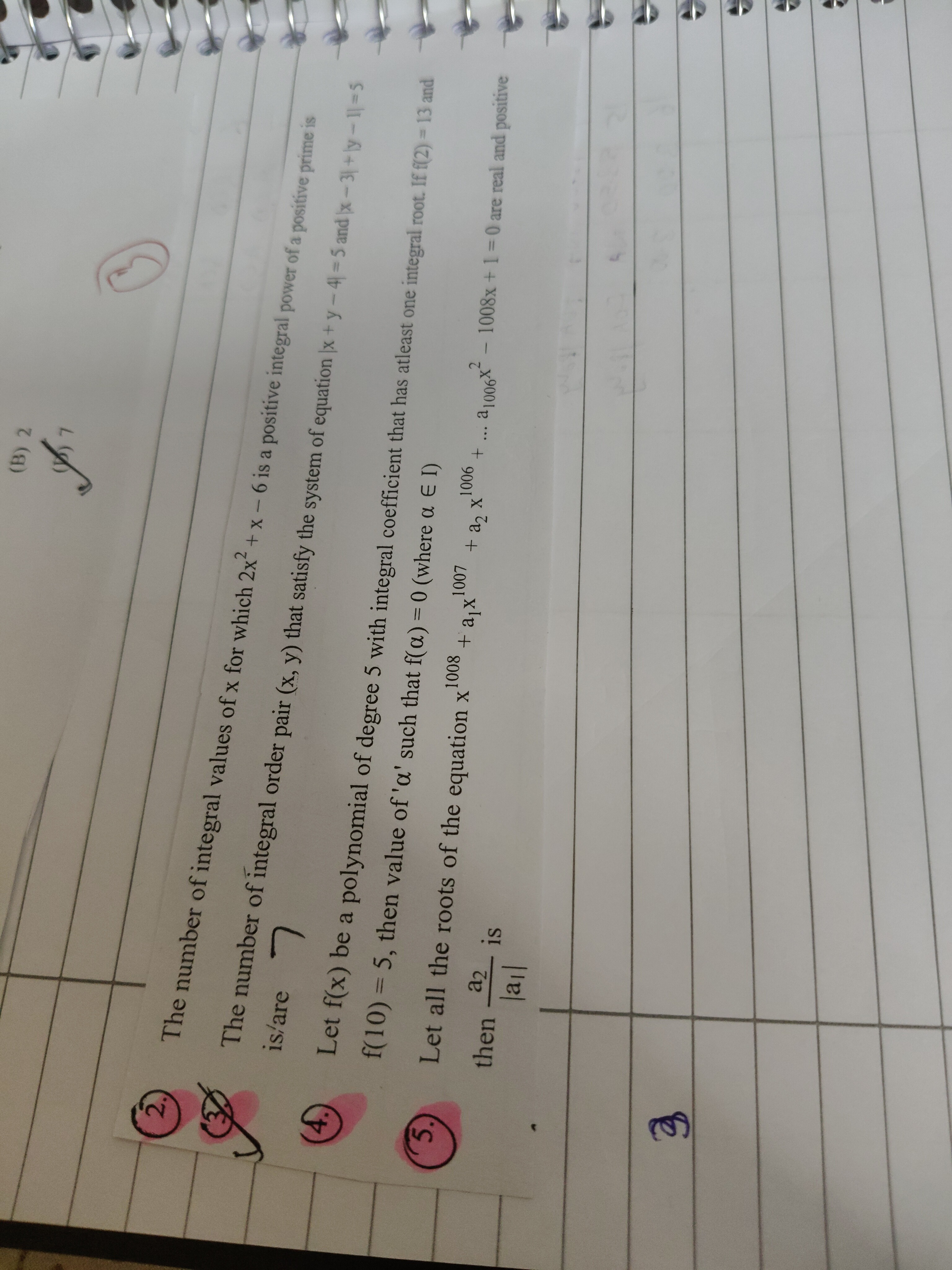Question
Question: The number of integral values of x for which $2x^2 + x - 6$ is a positive integral power of a positi...
The number of integral values of x for which 2x2+x−6 is a positive integral power of a positive prime is

3
Solution
Let the given expression be E=2x2+x−6. We are looking for integral values of x such that E is a positive integral power of a positive prime.
First, factorize the quadratic expression: 2x2+x−6=2x2+4x−3x−6=2x(x+2)−3(x+2)=(2x−3)(x+2).
So, we need (2x−3)(x+2)=pk, where p is a positive prime and k is a positive integer. Since x is an integer, both (2x−3) and (x+2) are integers. For their product to be a positive power of a prime, both factors must be powers of the same prime p, and they must have the same sign (both positive or both negative).
Let A=x+2 and B=2x−3. So AB=pk. We can express B in terms of A: 2A=2(x+2)=2x+4. Then 2A−B=(2x+4)−(2x−3)=7. So, we have the equation 2A−B=7, where A=pb and B=pa for some non-negative integers a,b (since A and B are factors of pk). Thus, 2pb−pa=7.
Case 1: Both factors A and B are positive. This implies x+2>0⟹x>−2 and 2x−3>0⟹x>3/2. So, for integer x, we must have x≥2. In this case, pa>0 and pb>0.
We need to solve 2pb−pa=7 for prime p and non-negative integers a,b.
Subcase 1.1: p=2. The equation becomes 2⋅2b−2a=7, which simplifies to 2b+1−2a=7. If a=0, then 2b+1−1=7⟹2b+1=8=23. This gives b+1=3⟹b=2. So, p=2,a=0,b=2. A=x+2=pb=22=4⟹x=2. B=2x−3=pa=20=1. Check: (2x−3)(x+2)=(1)(4)=4=22. This is a positive integral power of a positive prime (2). So x=2 is a solution.
If a≥1: 2a(2b+1−a−1)=7. Since 7 is a prime number, 2a must be a factor of 7. The only positive integer factor of 7 that is a power of 2 is 20=1. So a must be 0, which we already covered. Thus, for p=2, the only solution is x=2.
Subcase 1.2: p=3. The equation becomes 2⋅3b−3a=7. If a=0, 2⋅3b−1=7⟹2⋅3b=8⟹3b=4. No integer b satisfies this. If b=0, 2⋅1−3a=7⟹3a=−5. No solution. If a=1, 2⋅3b−3=7⟹2⋅3b=10⟹3b=5. No solution. If b=1, 2⋅3−3a=7⟹6−3a=7⟹3a=−1. No solution. If a≥1, 3a(2⋅3b−a−1)=7. 3a must be 1, so a=0, which we already covered. No solutions for p=3.
Subcase 1.3: p=5. The equation becomes 2⋅5b−5a=7. If a=0, 2⋅5b−1=7⟹2⋅5b=8⟹5b=4. No solution. If b=0, 2⋅1−5a=7⟹5a=−5. No solution. No solutions for p=5.
Subcase 1.4: p=7. The equation becomes 2⋅7b−7a=7. Divide by 7: 2⋅7b−1−7a−1=1. For this equation to hold, either a−1=0 or b−1=0, or both are greater than 0. If a−1=0⟹a=1: 2⋅7b−1−70=1⟹2⋅7b−1−1=1⟹2⋅7b−1=2⟹7b−1=1=70. This gives b−1=0⟹b=1. So, p=7,a=1,b=1. A=x+2=pb=71=7⟹x=5. B=2x−3=pa=71=7. Check: (2x−3)(x+2)=(7)(7)=49=72. This is a positive integral power of a positive prime (7). So x=5 is a solution.
If b−1=0⟹b=1: 2⋅70−7a−1=1⟹2−7a−1=1⟹7a−1=1=70. This gives a−1=0⟹a=1. This leads to the same solution x=5.
If a−1>0 and b−1>0: 7a−1(2⋅7b−a−1)=1 (assuming a≤b) or 7b−1(2−7a−b)=1 (assuming b<a). For the product to be 1, both factors must be 1. 7a−1=1⟹a−1=0⟹a=1. 2⋅7b−a−1=1⟹2⋅7b−a=2⟹7b−a=1⟹b−a=0⟹b=a. This again leads to a=b=1. Thus, for p=7, the only solution is x=5.
Subcase 1.5: For p>7. The equation is 2pb−pa=7. If a=0, 2pb−1=7⟹2pb=8⟹pb=4. Since p is a prime, p must be 2. But we assumed p>7. No solutions. If b=0, 2−pa=7⟹pa=−5. No solution. If a≥1 and b≥1: If a=b, 2pa−pa=7⟹pa=7. This means p=7 and a=1, which we already found (x=5). If a<b, pa(2pb−a−1)=7. Since p is prime, pa must be 1 or 7. If pa=1, then a=0, which we already covered. If pa=7, then p=7 and a=1, which we already found. If a>b, pb(2−pa−b)=7. Since p is prime, pb must be 1 or 7. If pb=1, then b=0, which we already covered. If pb=7, then p=7 and b=1, which we already found. So, there are no new solutions for p>7 when A,B>0.
Case 2: Both factors A and B are negative. This implies x+2<0⟹x<−2 and 2x−3<0⟹x<3/2. So, for integer x, we must have x≤−3. Let A=−pb and B=−pa for some non-negative integers a,b. The equation 2A−B=7 becomes 2(−pb)−(−pa)=7⟹−2pb+pa=7⟹pa−2pb=7.
Subcase 2.1: p=2. 2a−2⋅2b=7⟹2a−2b+1=7. If b=0, 2a−2=7⟹2a=9. No integer a. If b=1, 2a−4=7⟹2a=11. No integer a. If b=2, 2a−8=7⟹2a=15. No integer a. If b=3, 2a−16=7⟹2a=23. No integer a. In general, 2a−2b+1=7. Since 2a and 2b+1 are powers of 2, their difference can only be 7 if one of them is small. If a=0, 1−2b+1=7⟹2b+1=−6. No solution. If a=1, 2−2b+1=7⟹2b+1=−5. No solution. If a=2, 4−2b+1=7⟹2b+1=−3. No solution. If a=3, 8−2b+1=7⟹2b+1=1⟹b+1=0⟹b=−1. Not a non-negative integer. If a≥1: 2b+1(2a−(b+1)−1)=7 (assuming a>b+1) or 2a(1−2b+1−a)=7 (assuming a<b+1). If a>b+1: 2b+1 must be 1, so b+1=0⟹b=−1. Not allowed. If a<b+1: 2a must be 1, so a=0. Not allowed. No solutions for p=2 in this case.
Subcase 2.2: p=3. 3a−2⋅3b=7. If b=0, 3a−2=7⟹3a=9=32. This gives a=2. So, p=3,a=2,b=0. A=x+2=−pb=−30=−1⟹x=−3. B=2x−3=−pa=−32=−9. Check: (2x−3)(x+2)=(−9)(−1)=9=32. This is a positive integral power of a positive prime (3). So x=−3 is a solution.
If b≥1: 3b(3a−b−2)=7. Since 7 is prime, 3b must be 1. So b=0, which we already covered. No new solutions for p=3.
Subcase 2.3: For p>3. The equation is pa−2pb=7. If b=0, pa−2=7⟹pa=9. This implies p=3 and a=2, which we already found (x=−3). But we assumed p>3. No solutions. If a=0, 1−2pb=7⟹2pb=−6⟹pb=−3. No solution. If a=b, pa−2pa=7⟹−pa=7⟹pa=−7. No solution. If a>b: pb(pa−b−2)=7. pb must be 1 or 7. If pb=1, then b=0, which we already covered. If pb=7, then p=7 and b=1. Then pa−b−2=1⟹7a−1=3. No integer a. If a<b: pa(1−2pb−a)=7. pa must be 1 or 7. If pa=1, then a=0, which we already covered. If pa=7, then p=7 and a=1. Then 1−2pb−a=1⟹2pb−a=0. No solution. No new solutions for p>3 in this case.
Combining all solutions for x: From Case 1 (positive factors): x=2 and x=5. From Case 2 (negative factors): x=−3.
The integral values of x are −3,2,5. The number of integral values of x is 3.
The final answer is 3.
